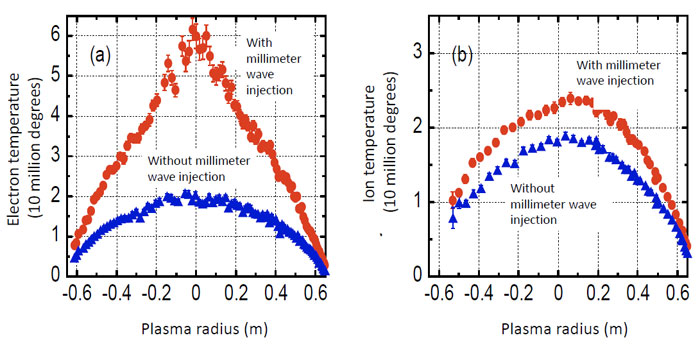HOME > Research Activities > Research Updates >
In the future fusion reactor, high-energy helium born from the fusion reaction of hydrogen isotopes will maintain the fusion reaction by heating plasma. Helium primarily heats electrons in plasma (in the condition in which atoms are separated into ions and electrons). By the movement of heat from electrons heated to an extremely high temperature to ions, ions are heated indirectly. In order to maintain the fusion reaction without bringing in heat from outside, through heat that moves from electrons to ions it is necessary to maintain the ion temperature at more than one hundred million degrees. Accordingly, in the condition in which electron heating is principal clarifying to what temperature ions may reach through the process in which heat moves from electrons to ions is one of the important issues in seeking to realize fusion energy generation.
The movement of heat from electrons to ions occurs when electrons and ions collide inside the plasma. In order for the electron-ion collision to be sufficiently frequent, it is necessary for the plasma density to be high. Further, because heat moves from a high temperature to a low temperature, in order to heat ions by the heat transfer from electrons, the electron temperature must be higher than the ion temperature. In the case in which the ion temperature is higher than the electron temperature, heat will move from the ion toward the electron. That is, in order to investigate heat transfer from electrons to ions, it is necessary to generate a high-density plasma having a sufficient heat difference between the electron and the ion.
In the Large Helical Device (LHD), in order to heat plasma we are using a device for generating high frequency electromagnetic waves that is called a gyrotron and which resembles an electric range used in homes but that has been enlarged. The electromagnetic waves that are generated by the gyrotron heat the electrons in the plasma because they have an extremely high frequency (from approximately 70 gigahertz to 150 gigahertz). However, the ions are not heated. (That is, we can produce the situation in which the electron heating is principal.) These electromagnetic waves are called millimeter waves because their wavelengths are several millimeters. In the LHD, we use five gyrotrons that produce an output of approximately 1,000 kilowatts each (approximately 1,000 times that of a household electric range). At its maximum output, it is possible to inject millimeter waves of 5,400 kilowatts into the plasma. By using these high power millimeter waves, it has become possible to generate a high-density plasma having the electron temperature sufficiently higher than the ion temperature. In an experiment in which we gradually increased the output of millimeter waves injected into a plasma, we clarified that the electron temperature increases together with increases in the millimeter output and that the ion temperature gradually increases while the temperature difference between the electron and the ion grows. As experimental results in which plasmas of a variety of densities were generated and the experiments were conducted under the same kind of conditions, it was shown that by the increase of collision frequency between electrons and ions that is caused by the density increase of the plasma, heat quantity transferred from electrons to ions grew, and the increase of ion pressure (the product of the temperature and the density) grew.
From this research, we clarified experimentally for the first time that, under the condition in which an electron is primarily heated, heat transfer from an electron to an ion occurs in the plasma and ion temperature increases. Further, we were able to indicate ion heating in various density conditions and the quantity of that heating. These results, with regard to the future fusion reactor, will provide important knowledge for being able to predict to what extent the ion temperature can be achieved under a condition in which there is no heat source from outside the plasma.

Image: (a) shows electron temperature distribution; (b) shows ion temperature distribution
(Blue color) shows the temperature without the millimeter wave injection.
(Red color) indicates the temperature with the millimeter wave injection. Injecting the millimeter wave makes the electron temperature rise. Heat then moves from the electron to the ion, and the ion temperature rises. The average density of the plasma at this time is 21 trillion parts/cc.
